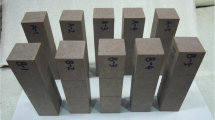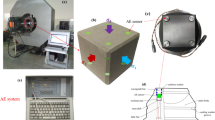Abstract
In the present work, the Brazilian tests for six sandstone samples were carried out. The acoustic emission (AE) method was applied to analyze the characteristics of the crack propagating mode and further to classify the cracking mode during the whole sandstone lump Brazilian splitting process. The study results showed that the AE event produced during the whole loading process, and different loading stages demonstrate different AE features. The amplitude of AE signals was increasing along with the loading stress, and there is a period of quiet time before the failure of the sample. It also concluded that more than 99% of the whole cracking signals are classified as tensile mode, and there are precious few shear cracks that occurred during the Brazilian test; the central frequency of the occurrence of the tensile crack is 138.58 kHz.











Similar content being viewed by others
Data Availability Statement
The data are available and explained in this article, readers can access the data supporting the conclusions of this study.
References
Aggelis DG, Shiotani T, Terazawa M (2010) Assessment of construction joint effect in full-scale concrete beams by acoustic emission activity. J Eng Mech 136(7):906–912
Cai M, Kaiser PK (2007) FLAC/PFC coupled numerical simulation of AE in large-scale underground excavations. Int J Rock Mech Min Sci 44(4):550–564
Carpinteri A, Cardone F, Lacidogna G (2010) Energy emissions from failure phe-nomena: mechanical, electromagnetic, nuclear. Exp Mech 50:1235–1243
Chen G, Xu P, Mi G et al (2019) Compressive strength and cracking of composite concrete in hot-humid environments based on microscopic quantitative analysis[J]. Construct Build Mater 225(20):441–451
Das AK, Suthar D, Leung CKY (2019) Machine learning based crack mode classification from unlabeled acoustic emission waveform features[J]. Cem Concr Res 121:42–57
Eberhardt E (1997) Changes in acoustic event properties with progressive fracture damage. Int J Rock Mech Min Sci 34:3–4
Farnam Y (2015) Weiss, et al. Acoustic emission waveform characterization of crack origin and mode in fractured and ASR damaged concrete[J]. Cement Concrete Compos
Fu JH, Huang BX, Liu CY, Yang W, Wang LF (2011) Study on acoustic emission features of coal sample Brazilian splitting. Coal Sci Technol 4(39):25–28
Lei R, Zhang Z, Ge Z, et al. (2020) Deformation localization and cracking processes of sandstone containing two flaws of different geometric arrangements[J]. Fatigue & Fracture of Engineering Materials & Structures
Gu A, Luo Y, Xu B (2015) Characteristic identification of cracking acoustic emission signals in concrete beam based on hilbert-huang transform[C]//Springer in Physics. Springer Proceedings in Physics
Gu Q, Ma Q, Tan Y et al (2019) Acoustic emission characteristics and damage model of cement mortar under uniaxial compression[J]. Construct Build Mater 213(20):377–385
Hardy HR (1997) Emergence of acoustic emission/microseismic activity as a tool in geomechanics. In: Proceedings of the First Conference on Acoustic Emission/Microseismic Activity in Geologic Structures and Materials, University Park. Edited by H.R. Hardy and L.W. Leighton, Trans Tech Puplications, Clausthal Zellerfeld, pp 3–31
Hatheway AW (2009) The complete ISRM suggested methods for rock characterization, testing and monitoring; 1974-2006[J]. Environ Eng Geoence 15(1):47–48
Hawkins AB, Ulusay R, Hudson JA (2009) The complete ISRM suggested methods for rock characterisation, testing and monitoring[J]. Bull Eng Geol Environ
Joseph FL (2001) Acoustic emission at failure in quasi-brittle materials. Constr Build Mater 15:225–233
Kong B, Wang E, Li Z et al (2017) Acoustic emission signals frequency-amplitude characteristics of sandstone after thermal treated under uniaxial compression[J]. J Appl Geophys 136:190–197
Kurz JH, Finck F, Grosse CU, Reinhardt HW (2006) Stress drop and stress redis-tribution in concrete quantified over time by the b-value analysis. Struct Health Monit 5:69–81
Luo PH, Yu XB, Deng Q (2010) Acoustic emission study of Rocks under Brizilian test. Nonferrous Metals 62(2):44–48
Matikas TE (2008) Influence of material processing and interface on the fiber frag-mentation process in titanium matrix composites. Compos Interfaces 15(4):363–377
Miaomiao W, Chengxuan T, Jing M et al (2017) Crack classification and evolution in anisotropic shale during cyclic loading tests by acoustic emission[J]. J Geophys Eng 4:4
Ohno K, Ohtsu M (2010) Crack classification in concrete based on acoustic emission. Constr Build Mater 24(12):2339–2346
Poddar B, Giurgiutiu V (2017) Detectability of crack lengths from acoustic emissions using physics of wave propagation in plate structures[J]. J Nondestr Eval 36(2):41
Prem PR, Murthy AR (2016) Acoustic emission monitoring of reinforced concrete beams subjected to four-point-bending[J]. Appl Acoust, S0003682X16302316
Ranjith PG (2008) A study of effect of displacement rate and moisture content on the mechanical properties of concrete: use of acoustic emission. Mech Mater 40:453–469
Shiotani T (2001) Detection and evaluation of AE waves due to rock deformation. Constr Build Mater 15:235–246
Shipeng X (2019) Numerical simulation research of failure and acoustic emission characteristics of parallel fractured sandstone[J]. Safety Coal Mines
Tang SF (2010) Characteristics of acoustic emission signals in damp cracking coal rocks. Mining Sci Technol 20:0143–0147
Tra V, Kim J Y, Jeong I, et al. (2020) An acoustic emission technique for crack modes classification in concrete structures[J]. Sustainability, p 12
Wang XT, Ge HK, Song LL, He TM, Xin W (2011) Experimental study of two types of rock sample acoustic emission events and kaiser effect point recognition approach. Chin J Roc Mech Eng 3(30):580–588
Yue JG, Kunnath SK, Xiao Y (2020) Uniaxial concrete tension damage evolution using acoustic emission monitoring[J]. Constr Build Mater 232:117281
Zhou JW, Xu WY, Yang XG (2010) A microcrack damage model for brittle rocks under uniaxial compression. Mech Res Commun 37:399–405
Zhu WC, Huang ZP, Tang CA, Feng MZ (2004) Numerical simulation on failure process of pre-cracked Brazilian disk specimen of rock. Rock Soil Mech 10(25):1609–1612
Acknowledgements
This work was supported by theYouth Science and Technology Talent Growth Project of Guizhou Provincial Education Department ([2020]155), Research and development project of Guizhou University of Engineering Science (Grant No: G2018016), Technology top talent support project of Guizhou Provincial Education Department ([2017]098), and Technology platform and talent team plan project ([2018]5622).
Author information
Authors and Affiliations
Corresponding author
Ethics declarations
Conflict of interest
No conflict of interest exists in the submission of this manuscript, and the manuscript is approved by all authors for publication.
Additional information
Publisher's Note
Springer Nature remains neutral with regard to jurisdictional claims in published maps and institutional affiliations.
Rights and permissions
About this article
Cite this article
Zhang, X., Cui, X., Tang, Q. et al. Acoustic Emission Investigation on Crack Propagation Mode of Sandstone During Brazil Splitting Process. Geotech Geol Eng 39, 2863–2870 (2021). https://doi.org/10.1007/s10706-020-01660-4
Received:
Accepted:
Published:
Issue Date:
DOI: https://doi.org/10.1007/s10706-020-01660-4




